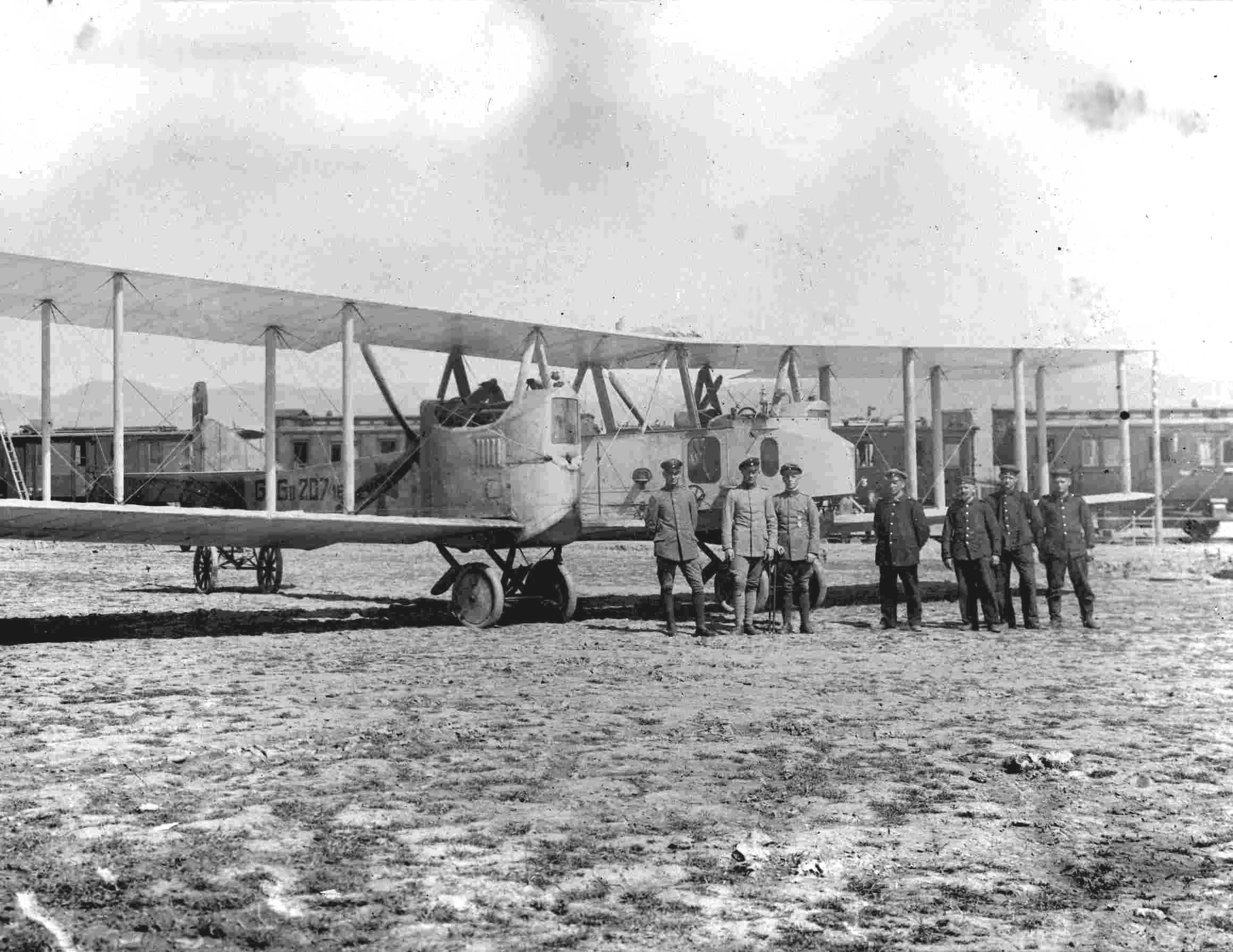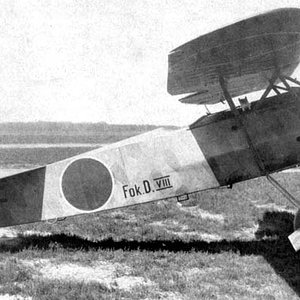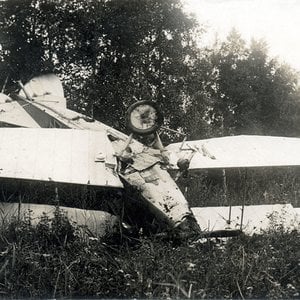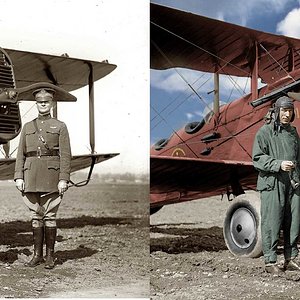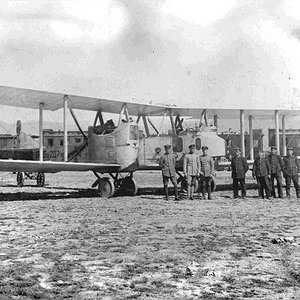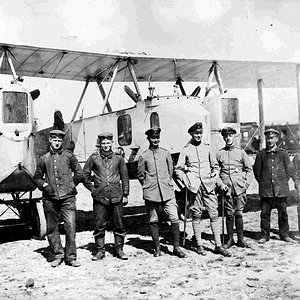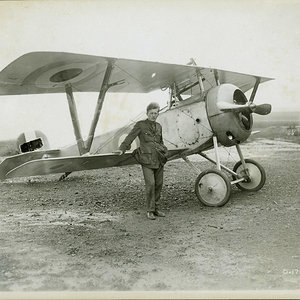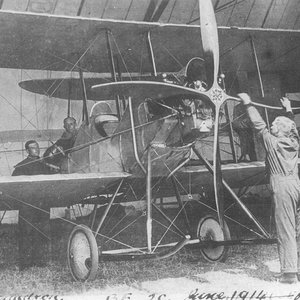Navigation
Install the app
How to install the app on iOS
Follow along with the video below to see how to install our site as a web app on your home screen.
Note: This feature may not be available in some browsers.
More options
You are using an out of date browser. It may not display this or other websites correctly.
You should upgrade or use an alternative browser.
You should upgrade or use an alternative browser.
Kempf's Gotha Go GII 207/16 in Hudowa April 1917 KG IV, Kempf is third from the left.
Design and development
The Gotha G.II was an entirely new biplane designed by Hans Burkhard, who had previously reworked Oskar Ursinus's design for the G.I to make it suitable for mass-production.[1] Burkhard abandoned the G.I's unorthodox configuration in favor of a more conventional design with the fuselage mounted on the bottom wing rather than the top. In deciding this, he had the benefit of greater pilot experience to draw upon. The difficulties of asymmetric thrust created by losing an engine on a twin-engine design had proved to be not nearly as bad as Ursinus had originally believed, and therefore the G.I's unusual design was really an answer to a non-existent problem.[2] Furthermore, Burkhard had the opportunity to rebuild a crashed G.I (serial number 9/15) and re-arrange its components to place the fuselage on the lower wing, and found this design workable, while also removing the grave danger to the crew that landing accidents posed.[3]
The G.II carried a crew of three and a defensive armament of two 7.92 mm (.312 in) machine guns. The forward section of the fuselage was skinned in plywood, with the remainder covered in fabric. The fuselage and two very large nacelles were mounted on the lower wing. Each nacelle contained fuel and oil tanks beneath a geared eight-cylinder 160 KW (220 hp) Mercedes D.IV engines driving pusher propellers. The undercarriage was unusual, being quadricycle in arrangement with a pair of wheels mounted at the front and rear of each engine nacelle. This feature was intended to remove the possibility of a nose-over on landing.[4] In fact, the nacelles and undercarriage constituted fully self-contained, wheeled units intended to facilitate construction and maintenance.[5] The entire aircraft was intended to be easily dismantled so that fuselage, engines, and wings would easily fit onto three railway flatcars.[6]
The G.II prototype first flew in March 1916, and testing revealed several shortcomings. The most significant problem was that the aircraft was not capable of carrying the bombload that was specified by the Idflieg.[7] This was solved by a redesign of the wing cellule to extend its span.[8] At the same time, it was changed from a two-bay to a three-bay structure.[9] The second issue was that the undercarriage arrangement made for very long and uncontrollable landing rolls.[10] This was solved by changing it to a conventional tailskid configuration.[11] Other revisions included horn-balanced ailerons and a triangular vertical fin. In this configuration, production commenced in April 1916.
Specifications (production version)
Data from [19]
General characteristics
Crew: 3
Length: ()
Wingspan: 23.70 (77 ft 9 in)
Height: ()
Wing area: 89.5 m² (963 ft²)
Empty weight: 2,182 kg (4,810 lb)
Max. takeoff weight: 3,192 kg (7,037 lb)
Powerplant: 2 × Mercedes D.IV inline engine, 164 kW (220 hp) each
Performance
Maximum speed: 148 km/h (92 mph)
Rate of climb: 1.8 m/s (350 ft/min)
Armament
2 × 7.92 mm (.312 in) Parabellum MG14 machine guns
450[citation needed] kg of bombs
Design and development
The Gotha G.II was an entirely new biplane designed by Hans Burkhard, who had previously reworked Oskar Ursinus's design for the G.I to make it suitable for mass-production.[1] Burkhard abandoned the G.I's unorthodox configuration in favor of a more conventional design with the fuselage mounted on the bottom wing rather than the top. In deciding this, he had the benefit of greater pilot experience to draw upon. The difficulties of asymmetric thrust created by losing an engine on a twin-engine design had proved to be not nearly as bad as Ursinus had originally believed, and therefore the G.I's unusual design was really an answer to a non-existent problem.[2] Furthermore, Burkhard had the opportunity to rebuild a crashed G.I (serial number 9/15) and re-arrange its components to place the fuselage on the lower wing, and found this design workable, while also removing the grave danger to the crew that landing accidents posed.[3]
The G.II carried a crew of three and a defensive armament of two 7.92 mm (.312 in) machine guns. The forward section of the fuselage was skinned in plywood, with the remainder covered in fabric. The fuselage and two very large nacelles were mounted on the lower wing. Each nacelle contained fuel and oil tanks beneath a geared eight-cylinder 160 KW (220 hp) Mercedes D.IV engines driving pusher propellers. The undercarriage was unusual, being quadricycle in arrangement with a pair of wheels mounted at the front and rear of each engine nacelle. This feature was intended to remove the possibility of a nose-over on landing.[4] In fact, the nacelles and undercarriage constituted fully self-contained, wheeled units intended to facilitate construction and maintenance.[5] The entire aircraft was intended to be easily dismantled so that fuselage, engines, and wings would easily fit onto three railway flatcars.[6]
The G.II prototype first flew in March 1916, and testing revealed several shortcomings. The most significant problem was that the aircraft was not capable of carrying the bombload that was specified by the Idflieg.[7] This was solved by a redesign of the wing cellule to extend its span.[8] At the same time, it was changed from a two-bay to a three-bay structure.[9] The second issue was that the undercarriage arrangement made for very long and uncontrollable landing rolls.[10] This was solved by changing it to a conventional tailskid configuration.[11] Other revisions included horn-balanced ailerons and a triangular vertical fin. In this configuration, production commenced in April 1916.
Specifications (production version)
Data from [19]
General characteristics
Crew: 3
Length: ()
Wingspan: 23.70 (77 ft 9 in)
Height: ()
Wing area: 89.5 m² (963 ft²)
Empty weight: 2,182 kg (4,810 lb)
Max. takeoff weight: 3,192 kg (7,037 lb)
Powerplant: 2 × Mercedes D.IV inline engine, 164 kW (220 hp) each
Performance
Maximum speed: 148 km/h (92 mph)
Rate of climb: 1.8 m/s (350 ft/min)
Armament
2 × 7.92 mm (.312 in) Parabellum MG14 machine guns
450[citation needed] kg of bombs

